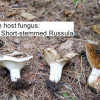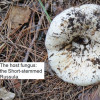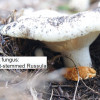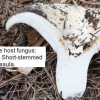Edible, therapeutic and toxic mushrooms

Habitat
The Lobster Mushroom is found in sandy soil, often on lower slopes in the company of pines. Alders that enrich the soil with nitrogen also contribute favourably. When a colony of Short-stemmed Russula is discovered without this parasitic fungus, one can append pieces of Lobster Mushroom to the Russula fruit bodies, push them slightly into the ground and ensure that the spores of the Lobster Mushrooms are in contact with the stems of the Russula. There’s a good chance a new colony will emerge. In the second year, one or two Lobster Mushrooms will be harvested, but quantities will increase with time.
Fruit body
Orange yellow, orange to red. The fruitbodies have a multitude of forms, different from each other.
Comments
Send a comment
Lobster Mushrooms are rarely parasitized by insects if the Short-stemmed Russula were not infested before. Slugs may come to dig cavities by burrowing in from the exterior, but these cavities quickly regain the orange colour of the fruit bodies and often go unnoticed.
For more informations
Formation
For those who wish to improve their knowledge, register for the Foundation's training program on this site and receive a certificate confirming the fruit of your efforts.











































